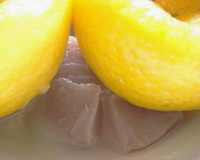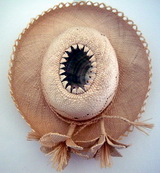This recipe was originally given to me by GranMary, my Rarotongan (Cook Islands) grandmother, and has since been updated to include the version from Jack Cooper, the "trader" from Trader Jacks, who was a dear friend of Granmary, and a special friend to the family. Thank you Jack!
We marinate the fish in lemon juice so that it is “cooked”. It is an ideal starter or light lunch. Has also been a great late breakfast on a summer’s day. All the flavours combine so well and come together as a fresh yet creamy salad. A staple throughout the Pacific with each country having their own version. Due to the overnight marinating is also an easy way to serve seafood without the mad rush of quick cooking prior to serving.
For a modern version to watch online, performed by renowned chef Sean Connolly, by my submission, go to - http://www.sbs.com.au/food/recipe/846/Raratonga_raw_fish_salad_with_coconut_(ika_mata)/search/true

Pictured: Ika Mata, Rarotongan Raw Fish Salad with Coconut
200g firm fleshed fish – tuna is favourite, otherwise snapper or cod
4 Lemons or limes, squeeze their juice
1 grated carrot
1 tomato, diced
½ capsicum, diced
4 chopped spring onions
Touch of garlic
¼ tsp fresh ginger
¼ tsp crushed red chillis or Tabasco
200ml coconut milk (good quality tinned coconut cream or coconut cream mixed with tinned coconut milk)
Pepper and salt
½ an iceberg lettuce
Optional - Handful fresh coriander to serve
Chop fish into bite sized pieces (15mm thick) and cover with fresh lemon/lime juice to marinate. Cover with the lemon halves and refrigerate at least ½ hour in a non-reactive bowl, some fish may take longer. Toss with salt. Stir at least once.
 Pictured: Ika Mata – tuna marinating in lemon juice
Pictured: Ika Mata – tuna marinating in lemon juice
Remove and drain from lemon juice, rinse to stop cooking. Mix with other ingredients in bowl.
Stir in some fresh lemon juice to coat.
Check seasoning. Place back in fridge to chill the dish.
Serve slightly chilled over lettuce leaf sprinkled with fresh coriander leaves, if using.
Serves 4 - 6
TasteTip- Coconut milk isn't the liquid from inside the nut, but the extract of freshly grated coconut flesh. The flesh is first soaked in hot water, then allowed to cool, after which the liquid is strained off. It's available in tins from Asian and Caribbean stores and larger supermarkets. Coconut cream is sold in hard blocks. It can be diluted with hot water before using or added straight to the simmering liquid in the pan. Both give a distinctive taste and smoothness to curries, sauces and rice.
An average coconut yields 3 - 4 cups of grated flesh, which will keep tightly covered in the refrigerator for 3 - 4 days, or frozen in portion size quantities up to 6 months.
You can purchase a coconut scraper if you are interested in making your own as per below:-
Coconut cream - Process 4 cups grated fresh coconut and 1 cup boiling water in food processor til well combined and milky. Strain through a sieve, pressing down on solids to extract as much liquid as possible. Discard flesh.
Coconut milk - repeat the process above with 4 cups fresh coconut and 2 cups boiling water.
Must use milk or cream on the same day, as it is highly perishable. However both can be frozen in ice trays, then cubes stored in freezer bags for up to 1 month.
In the 15th century, Columbus introduced the lemon to the New World and later when the Portuguese took it to Brazil none of the sailors on those early voyages knew that the Vitamin C content of their cargo would have been a far more effective remedy for the scurvy sufferers among them than the strange 'cures' doled out by apothecaries. The Cook Islanders are well known for understanding the need for vitamin C to ward off scurvy during their long journeys by vaka to Hawaii and New Zealand - they were pioneering sailors.

Pictured: Rarotongan Hat - these are particularly worn at church